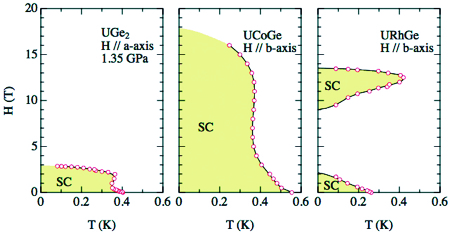The spins of the electrons forming the Cooper pairs in conventional superconductors are coupled in an anti-parallel way. In the so-called heavy-fermion ferromagnets, another means of coupling, namely the spin triplet state with equal-spin pairing makes possible the coexistence of magnetism and superconductivity. The figure displays the temperature variation of the superconducting critical field Hc
2 (above which superconductivity disappears) for three uranium-based ferromagnetic superconductors. Although superconductivity is a priori fragile – the critical temperatures are below 1 K – it is remarkably robust for a magnetic field since the Hc
2 values are large. In addition, the phase diagrams show the peculiar S-shaped curve or field re-entrant superconductivity.
Since the effect of the field on the electron spins in the triplet state cannot be responsible for the breaking of Cooper pairs, it is the Lorentz force acting on the electrons which drives this pair breaking. If the effective mass of the electrons is enhanced with the field, the superconducting transition temperature is raised and re-entrance can be observed. In the physics of correlated electron systems, the quantum singularities can be tuned by a pressure or chemical doping. In these ferromagnetic superconductors, the magnetic field and its direction relative to the crystal axes are the tuning parameters. Precise control of the field-orientation and the synthesis of high quality crystals are the keys for new advances in this domain.

Temperature variation of the critical field Hc2 in ferromagnetic superconductors UGe2, UCoGe and URhGe.